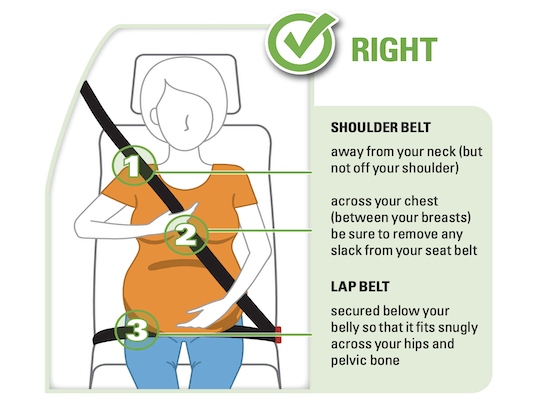Is driving when pregnant safe? Yes, of course it is, but you must take extra precautions during that time. As long as you feel comfortable being behind the wheel, and you can reach all the various elements such as pedals to maneuver the car, then you’re okay to drive. If you’re dealing with severe morning sickness, then stay off the road during the first hours of the day.
Use eTags© to Quickly Complete Your DMV Service. Renewals, Title Transfers and More, All Online!
For some women, driving adds to the discomfort that typically comes with pregnancy, especially as they get closer to their due date. Sometimes the seatbelt is too tight or they suffer from lower back pain due to long commutes.
Let’s take a closer look at how you can stay safe on the road during your pregnancy.
#1 Always buckle up before driving while pregnant
The safest type of seat belt to wear when pregnant is a lap and shoulder belt combo. Place the lap belt under your belly, touching your thighs, and low and snug on your hip bones. The shoulder belt should fit snugly across the center of your shoulder and chest. Never place it under your arm or behind your back.
The correct use of seatbelt could prevent serious fetal injuries in the event of a car accident. So remember, you may have to readjust settings as your belly grows and you move through your trimesters.
#2 Slide your seat back away from the steering wheel
When driving, make sure your belly is at a safe distance away from the air bag. Your breast bone should be at lease 10 inches away from steering wheel to help prevent injuries.

#3 Airbags are safe for pregnant women
Air bags reduce the risk of injury for pregnant mothers and don’t increase the risk of injury to their unborn babies. Just make sure your airbags are switched on. Move the seat back as far as you can while still reaching the pedals. Tilt the steering wheel so that it’s angled toward your breastbone, not your head or your belly.
Note that safety experts recommend activating both airbags while driving or sitting in the front passenger seat.
SEE ALSO: April Is Distracted Driving Awareness Month – Safety Guide
#4 Adjust your seat according to your safety needs
When it comes to adjusting your seat, it’s important to remember that as your belly grow, your settings will change. There’s a great difference between driving during the initial stage of pregnancy and between your last months.
Make sure you’re in an upright position, always keeping great distance with steering wheel. Avoid reclining the seat too much or your belly touching the steering wheel.

#5 Schedule stops while driving
Avoid driving long distances while pregnant. If you must, you may have to safely stop to stretch your legs, walk, and relax. Stopping for a bit may also give you a chance to grab a snack and use the restroom.
Keep in mind that sitting behind the wheel could also be painful. Bringing a cushion helps you handle it better since it’s all about your safety and comfort.
SEE ALSO: 5 Defensive Driving Tips to Keep You Safe On The Road








